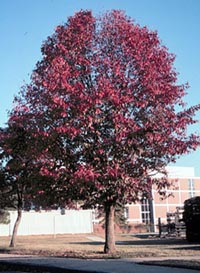Resource Library
Plant of the Week: Tupelo (Blackgum, Sourgum)
The University of Arkansas System Division of Agriculture does not promote, support or recommend plants featured in "Plant of the Week." Please consult your local Extension office for plants suitable for your region.
Plant of the Week
Blackgum, Sourgum, Tupelo
Latin: Nyssa sylvatica

The blackgum is the earliest of our native trees to turn color in the fall, but it
does it slowly over a six-week period. In the beginning, only a few leaves turn a
bright red; but by early October, the tree is a forest standout with its glossy red
leaves glistening in the autumn sun.
The blackgum is a member of a small plant family, the Nyssaceae. The family includes
only three genera important as ornamentals.
The blackgum ranges over most of the eastern states in its various forms, appearing
from the swamps of eastern Maine to the pine thickets of east Texas. In Arkansas,
it’s found statewide in upland and lowland sites, but nowhere does it form dense stands.
It only appears as scattered trees in the forest.
Blackgum grows to 60 feet tall and usually is less than 25 feet across. It usually
has a single, straight trunk with branches that emerge at right angles like those
of pine trees. Young trees are often pyramidal, like a pin oak, while older trees
may be more columnar or round-headed. The ends of the branches are often droop, giving
the tree a distinctive winter silhouette.
Leaves are up to 5 inches long, one third as wide and glossy green on the upper surface.
The tree produces tiny greenish-white flowers high in the branches that are followed
in the fall by blue-black berries about the size of a peanut.
The common names of this tree are a bit of a puzzle because it’s extremely dry-wooded
and doesn’t produce sap, which is required to produce a "gum." Thee tree has never
been used to produce either a sour gum or a black gum, so the common name is probably
due to a bit of botanical confusion among woodsmen.
The name "Tupelo" is an adaptation of the Creek Indian language. They’re the original
inhabitants of Georgia, Florida and Alabama. "Eto" means tree, and "opelwv" means
swamp.
To the lumberman, blackgum is difficult to work with because it has interconnected
grain that runs lengthwise with the tree, but also crosswise, making splitting almost
impossible. This interlocked grain has made the wood useful for blocks in agricultural
equipment where wooden parts that won’t split are needed. The wood has also been used
to make baskets and handles.
A friend who grew up in the backwoods of Arkansas used twigs of the tree as a natural
toothbrush. The wood splinters out in all directions when it’s chewed, making a little
pipestem brush.
As a landscape tree, the blackgum is considered first rate among experts such as
Mike Dirr in Georgia. I like the tree, but I’m disappointed in how slow it grows.
There’s a grove of eight shade tree species that were planted near the University
of Arkansas campus in 1971. After 30 years, the blackgum is only about half the size
of the other trees in the stand. It’s has trunk diameter of about 8 inches and a height
of 30 feet. The oaks, maples and tulip poplar are all 50-60 feet tall.
Many of our urban landscapes can accommodate a smaller tree more easily than a mammoth
oak, so sourgum does have its place. It does best in good alluvial soil, but it will
tolerate both dry and wet sites once it’s established.
Named cultivars are available that have been selected for fall color and plant form,
but none are readily available from retail nurseries. The tree is best transplanted
from container grown plants. The blackgum is not bothered by serious insect or disease
problems.
By: Gerald Klingaman, retired
Extension Horticulturist - Ornamentals
Extension News - September 8, 2000
The University of Arkansas System Division of Agriculture does not maintain lists of retail outlets where these plants can be purchased. Please check your local nursery or other retail outlets to ask about the availability of these plants for your growing area.